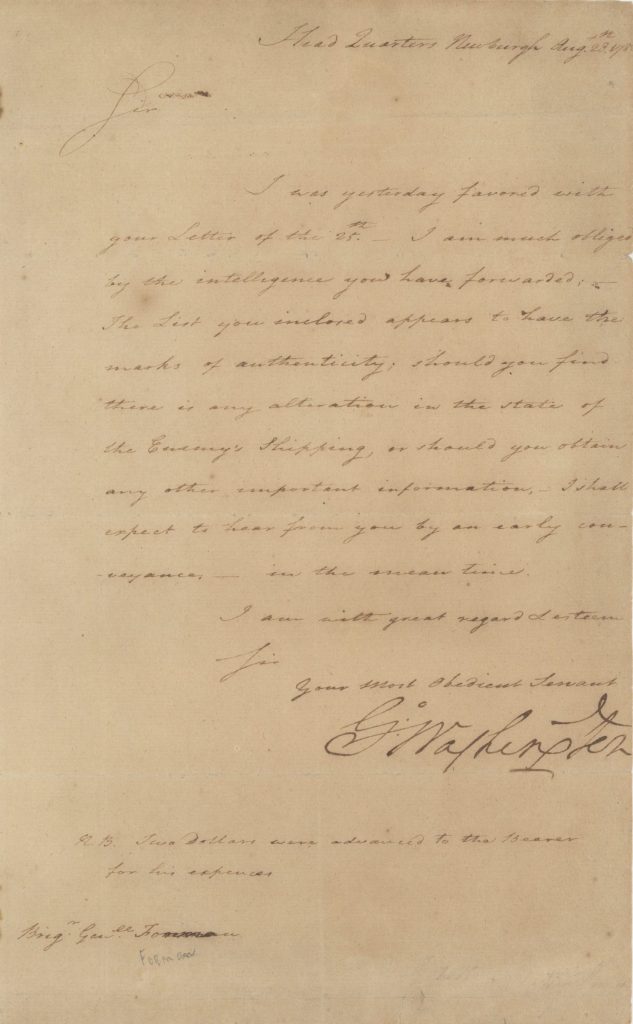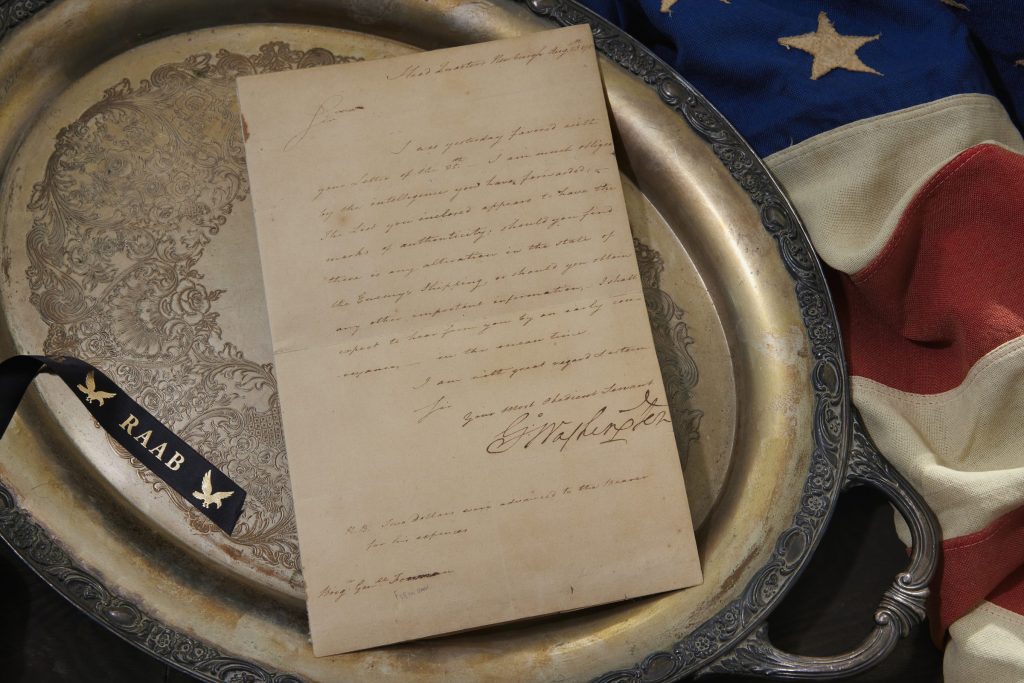General George Washington Writes One of His Chief Spymasters, Gathering Information on British Movements in New York and Issuing Further Orders





Responding to General Forman’s intelligence report on British activities in and off New York, Washington writes: “I am much obliged by the intelligence you have forwarded—The List you enclosed appears to have the marks of authenticity—should you find there is any alteration in the state of the Enemy’s shipping, or should you obtain any other important information, I shall expect to hear from you by an early conveyance…”
Forman had told Washington: “I am this minute furnished with a list of the British Naval Force at New York and now at Sea on this Station”
Letters of Washington to his intelligence chiefs, particularly issuing instructions, are uncommon; this is our first letter of his to General Forman
David Forman...
Forman had told Washington: “I am this minute furnished with a list of the British Naval Force at New York and now at Sea on this Station”
Letters of Washington to his intelligence chiefs, particularly issuing instructions, are uncommon; this is our first letter of his to General Forman
David Forman was a key member of George Washington’s intelligence network. During the Revolution, New York was the hub of British activity and the dispatch point of the British fleet. While the Culper Ring led by Benjamin Tallmadge spied on the British in the city of New York, Forman kept an eye on British ships in the area. He began his service in the Revolutionary War in 1776 as Lt. Colonel of a Battalion of Heard’s Brigade, New Jersey State Troops. He was soon promoted to Colonel. Forman suppressed a Loyalist uprising in Monmouth County in 1776, and was made Colonel in command of the New Jersey Militia. In January 1777, the Continental Congress authorized him to raise and lead Forman’s Additional Continental Regiment, which he did from January 1777 to July 1778. He served on the staff of Charles Lee at the Battle of Monmouth. He was then made Brigadier General of New Jersey Militia, commanding New Jersey State Troops until the end of the war.
But General Forman’s main fame was as Washington’s watchman and spy. In 1780, he organized intelligence detachments along the New Jersey coast and gathered information on enemy maritime movements, and the size, direction and destination of British ships operating off the New Jersey coast or leaving or arriving in New York. All this he sent on to Washington in dispatches, keeping him up to date on sightings. This remained important even after the victory at Yorktown in October 1781, as for quite some time it was far from certain that the British would negotiate an end to the war. Meanwhile the war continued. On August 19, 1782 took place the Battle of Blue Licks, in the Appalachian west, at which the British and their Indian allies inflicted heavy casualties and forced the retreat of Daniel Boone and the Kentucky militia. In response, George Rogers Clark led Kentucky militia on an expedition against the British into Ohio country. Meanwhile, peace talks between British and American diplomats got underway in Paris in May 1782. After months of difficult negotiations, the British and American diplomats signed the Preliminary Articles of Peace on November 30, 1782. Only then was peace in sight. A provisional peace treaty was signed on January 20, 1783, proclaiming an end to hostilities. But the formal agreement was not signed until September 3, 1783. It was not until November 1783 that British troops entirely evacuated New York City.
On August 18, 1782, even as the battle for the West was ongoing, Forman wrote Washington with a report on British activities. “Immediately I determined to…Collect what information I could respecting the Enemies naval strength at New York and its dependancies…but the activity of the Troops stationed in this Country has so fully interrupted the trade with New York and Sandy Hook that nothing can be learn’d with certainty…I shall in a few days be able to furnish your Excellency with Accurate Accounts of their Naval force—The Accounts I Collected yesterday Are That on Saturday the 10th Inst. a Fleet of Twenty Ships Arrived with part of the Savanah Garrison, part having been left at Charles Town, and part (the New levies) sent to Augustine, the Number Arrived at New York not known. It is also said Two Ships of the line Convoyed them, and I am the rather inclined to believe that Two ships of the line did Arrive with the Charles town fleet from the observation of Some [Good] Judges who observ’d them at the Time of their arrival—they say that Either of the Two are larger then Adml. Digby’s Ship The Lyon …[Robert Digby was in command of the North American station]. if They are of The line Then Digby has four Ships of 60 guns and upwards—one of Them an Old India Man Said to be quite Equal to a 64…. Your Excellency may depend upon it That They Have had 22 Ships & Sloops of War at one Time laying off and Cruising about Sandy Hook for upwards of Two Weeks. They have had a Number of Vessels prepared for the purpose of stopping up The Channel ways both Inside and without the Hook. Your Excellency I presume is well Informed that in 1779 they did Actually sink a Number of Vessels in Those Channel ways—This spring I had an opportunity of Conversing with a pilot from New York then a prisoner of War with us. he Told me those Vessels were destroyed and The Channel opened again in 48 hours after they were Sunk, and that it was impossible to Obstruct the passage in That way. I shall pay very particular attention to Every part of your Excellency’s Instructions…”
General Washington responded on August 25 with praise for Forman and the information he was providing: “I have been favored with your Letter of the 18th: and am much obliged by the readiness & zeal you manifest in your Endeavours to obtain the Intelligence I wish to receive from New York. It is really very extraordinary that no British fleet has yet appeared on our Coasts, in pursuit of the French squadron, which is now safely arrived in Boston Harbour. Your Chain of Expresses may extend to Morris Town only, where the Quarter Master will be directed to receive & forward your Dispatches to Head Quarters, without Delay—the particular Route to Morris Town, you will judge better than I can—my only preference would be given in favor of Safety & Expedition. With much Regard I am sir Your most Obedient & most humble Servt, G. Washington.”
That same day, August 25, Forman sent Washington an important update on British activities. “I am this minute furnished with a list of the British Naval Force at New York and now at Sea on this Station, and have the Honour to inclose to your Excellency a copy—the same Informant says a dispatch Brig Arrived at New York on Friday Evening the 23d Inst. that he was on Board her, and was Informed they Come from the West Indias with Twenty five Sail of Line of Battle Ships Commanded by Sr Samuel Hood and left the fleet off the Capes of Delaware Standing for Sandy Hook—This was the report from the people on Board—In addition to the list of Ships of War upon the New York Station I have annexe’d the Equipment of the Vessels prepared for Sinking. Tomorrow I Shall my Self Take a ride to the Sea shore to Examine into the Conduct of the look out posts, and if possible insure to myself the most rapid Information of the Arrival of any fleet. In a few days I Expect to be furnished with Some other lists of the British fleet on this Station—should there be any difference in the different accounts I will carefully note them.”
Washington responded, expressing his confidence in Forman’s information and issuing him additional instructions. Letter signed, Head Quarters Newburgh, August 28th, 1782, to Forman. “I was yesterday favored with your Letter of the 25th. I am much obliged by the intelligence you have forwarded—The List you enclosed appears to have the marks of authenticity—should you find there is any alteration in the state of the Enemy’s shipping, or should you obtain any other important information I shall expect to hear from you by an early conveyance. In the Mean time I am with great regd & esteem Sir Your Most Obedt. Hble. Servt., G. Washington.” A PS states, “Two dollars were advanced to the bearer for his expenses.” Lightly silked.
Letters of Washington to his intelligence chiefs are uncommon. Some years back we had a letter of Washington to Tallmadge; this is our first letter of his to Forman.

Frame, Display, Preserve
Each frame is custom constructed, using only proper museum archival materials. This includes:The finest frames, tailored to match the document you have chosen. These can period style, antiqued, gilded, wood, etc. Fabric mats, including silk and satin, as well as museum mat board with hand painted bevels. Attachment of the document to the matting to ensure its protection. This "hinging" is done according to archival standards. Protective "glass," or Tru Vue Optium Acrylic glazing, which is shatter resistant, 99% UV protective, and anti-reflective. You benefit from our decades of experience in designing and creating beautiful, compelling, and protective framed historical documents.
Learn more about our Framing Services















































































































